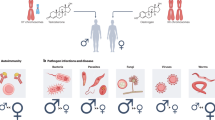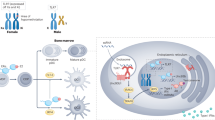Abstract
THE wood lemming, Myopus schisticolor Liljeborg, is distinguished by an aberrant sex ratio, with a considerable excess of females, and by the fact that some females produce only daughters1,2. Fredga and his associates3 have provided a basis for understanding both these characteristics. They observed that 82 out of 181 female wood lemmings studied (45%) had an XY sex chromosome constitution, with chromosomal G-banding and C-banding patterns indistinguishable from those of XY males. On the other hand, the XY females were anatomically normal and indistinguishable from XX females. Furthermore, meiotic studies3 showed that the germ line in the somatically XY females was XX. The second X chromosome in the germ cells must have arisen by non-disjunction from the single X present in the XY cells. Thus all progeny from such females must have received copies of the same X chromosome. How does one reconcile these observations with the apparent function of the Y chromosome in mammalian sex determination4, or with more recent evidence that a particular Y-linked gene which controls presence of H–Y antigen is critical for differentiation of the male gonad? We have approached these questions serologically by typing male and female wood lemmings for expression of H–Y antigen, and we have found that all female wood lemmings are H–Y−.
This is a preview of subscription content, access via your institution
Access options
Subscribe to this journal
Receive 51 print issues and online access
$199.00 per year
only $3.90 per issue
Buy this article
- Purchase on Springer Link
- Instant access to full article PDF
Prices may be subject to local taxes which are calculated during checkout
Similar content being viewed by others
References
Frank, F., Naturwissenschaften, 53, 90 (1966).
Kalela, O., and Oksala, T., Ann. Univ. Turkuensis, Ser. AII, 37, 1–24 (1966).
Fredga, K., Gropp, A., Winking, H., and Frank, F., Nature, 261, 225–227 (1976).
Ohno, S., Sex Chromosomes and Sex-Linked Genes (Springer, Berlin, 1967).
Wachtel, S. S., Koo, G. C., Zuckerman, E. E., et al., Proc. natn. Acad. Sci. U.S.A., 71, 1215–1218 (1974).
Wachtel, S. S., Transplant. Rev., 33, 33–61, (1976).
Bennett, D., Boyse, E. A., Lyon, M. F., Mathieson, B. J., Scheid, M., and Yanagisawa, K., Nature, 257, 236–238 (1975).
Wachtel, S. S., Koo, G. C., and Ohno, S., in New Concepts of the Testis in Normal, and Infertile Men: Morphology, Physiology, and Pathology (edit. by Troen, P., and Nankin, H. (Raven Press, New York, in the press).
Wachtel, S. S., et al. New Engl. J. Med. 295, 759–754 (1976).
Miller, D. A., Dev, V. G., Tantravahi, R., Miller, O. J., Schiffman, M. B., Yates, R. A., and Gluecksohn-Waelsch, S., Genetics, 78, 905–910 (1974).
Wachtel, S. S., Ohno, S., Koo, G. C., and Boyse, E. A., Nature, 257, 235–236 (1975).
Ohno, S., Christian, L. C., Wachtel, S. S., and Koo, G. C., Nature, 261, 597–599 (1976).
Bartlett, D. J., Grant, J. K., Pugh, M. A., and Aherne, W., J. Obstet. Gynec. Br. Commu., 75, 199–210 (1968).
Sternberg, W. H., Barclay, D. L., and Kloepfer, H. W., New Engl. J. Med., 278, 695–700, 1968.
Espiner, E. A., Veale, A. M. O., Sands, V. E., and Fitzgerald, P. H., New Engl. J. Med., 283, 6–11 (1970).
Author information
Authors and Affiliations
Rights and permissions
About this article
Cite this article
WACHTEL, S., Koo, G., OHNO, S. et al. H–Y antigen and the origin of XY female wood lemmings (Myopus schisticolor). Nature 264, 638–639 (1976). https://doi.org/10.1038/264638a0
Received:
Accepted:
Issue Date:
DOI: https://doi.org/10.1038/264638a0
This article is cited by
-
Female wood lemmings with the mutant X*-chromosome carry the H-Y transplantation antigen
Immunogenetics (1985)
-
Absence of H-Y antigen in a case of sporadic pure gonadal dysgenesis
Journal of Endocrinological Investigation (1984)
-
Variability in serologically detected male antigen titer and some resulting problems: A critical review
Human Genetics (1984)
-
New developments in vertebrate cytotaxonomy VII
Genetica (1984)
-
Sexual differentiation and H-Y antigen
Nature (1982)
Comments
By submitting a comment you agree to abide by our Terms and Community Guidelines. If you find something abusive or that does not comply with our terms or guidelines please flag it as inappropriate.



